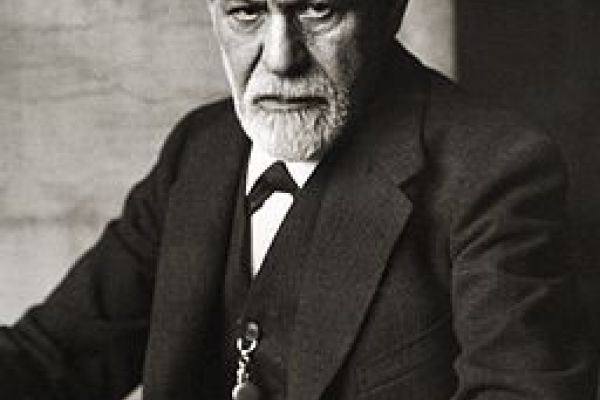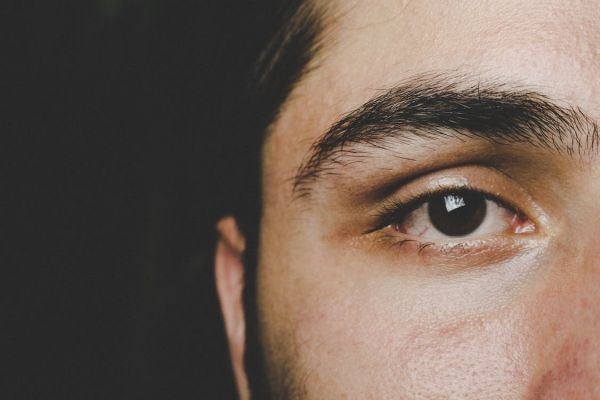Bertha Pappenheim (1859-1936)
Bertha Pappenheim, the original patient of psychoanalysis
Posted January 29, 2012
Bertha Pappenheim, always presented under the name of "Anna O." as the original patient of psychoanalysis, was actually never treated by Freud himself but by his friend and mentor Josef Breuer. She was born February 27, 1859 in Vienna to Jewish parents. Her father, Siegmund Pappenheim, had inherited a grain trading company and was considered a millionaire. Her mother, Recha Goldschmidt, came from an old Frankfurt family which counted among its members the poet Heinrich Heine. The Pappenheims were strictly Orthodox and Bertha received the traditional education of a höhere Tochter (girl of the upper middle class waiting to be sent on the "marriage market"): religious education (the study of Hebrew and biblical texts), foreign languages (English, French, Italian), needlepoint, piano, horseback riding. Bertha, who was a lively and very energetic young girl, suffocated in this confined life which she was later to denounce in an article "On the education of young women in the upper classes" (1898).
So Bertha took flight, first in a fantasy world she called her "private theater" and then in illness. The first symptoms appeared in the fall of 1880, at a time when Bertha looked after her father who had fallen ill with a pleurisy that was to prove fatal. Bertha had a persistent cough and at the end of November Josef Breuer was called upon. Breuer, a well-respected internist, was the physician of the Jewish high bourgeoisie and aristocracy in Vienna. He diagnosed a hysteria, upon which Bertha took to her bed and developed "in rapid succession" an impressive array of symptoms: pain in the left side of the occiput, blurred vision, hallucinations, various contractures and anesthesias, trigeminal neuralgia, "aphasia" (from March 1881 she spoke only in English), split personality and altered states of consciousness ("absences") during which she threw tantrums that afterwards she could not remember.
Breuer, who came to see her every day, noticed that her condition was improving each time he let her tell during her "absences" the sad stories of her private theater - a process she termed (in English) "talking cure" or "chimney sweeping". However, her condition worsened after the death of her father on April 5, 1881. She refused to eat and told no more fairy tales à la Hans Christian Andersen, but instead related morbid "tragedies". She also had negative hallucinations: she didn't see the people around her and recognized only Breuer. On April 15, Breuer called upon his colleague the psychiatrist Richard von Krafft-Ebing for a second opinion. Unconvinced of the authenticity of the patient's symptoms (she claimed to ignore his presence), Krafft-Ebing blew into her face the smoke of a piece of paper that he had ignited. This caused an explosion of anger on the part of Bertha who began to beat Breuer violently. Finally, on June 7, Breuer placed her forcibly in an annex to the clinic for nervous disorders run by his friend Dr. Hermann Breslauer at Inzersdorf. There she was quieted down with the help of large doses of chloral hydrate, the sedative of choice at the time. As a result, Bertha developed an addiction to chloral.
Once the patient was stabilized (in other words: drugged), the talking cure could resume. Bertha's stories had changed. During her altered states, she no longer told imaginary tales or tragedies: "What she reported was more and more concerned with her hallucinations and, for instance, the things that had annoyed her during the past days." When she told of the frustration that had been the source of a particular symptom, it would disappear miraculously. Breuer therefore set out to eliminate one by one her countless symptoms (for example, the 303 instances of a hysterical deafness). What followed was a therapeutic marathon that resulted, if we are to believe the case history published thirteen years later by Breuer in Studies on Hysteria, in a complete recovery by June 7, 1882 (the anniversary of her admission at the Inzersdorf clinic) following a final narration during which Bertha relived a scene at the bedside of her father that was supposed to have triggered her illness: "Immediately after its reproduction, she was able to speak German. She was moreover free from the innumerable disturbances which she had previously exhibited. After this she left Vienna and travelled for a while, but it was a considerable time before she regained her balance entirely. Since then she has enjoyed complete health." Freud as well would always describe "Anna O."'s talking cure as a "great therapeutic success" (1923).
As the research of historians Henri Ellenberger and Albrecht Hirschmüller has established, the reality is quite different. Bertha Pappenheim's treatment had in fact been for Breuer a veritable "ordeal", as he wrote later to his colleague the psychiatrist August Forel. The treatment had never shown any real progress and as early as in the fall of 1881 Breuer was already thinking of placing Bertha in another clinic, the Bellevue Sanatorium run by the psychiatrist Robert Binswanger in Kreuzlingen, Switzerland. Moreover, as we know from a letter sent October 31, 1883 by Freud to his fiancée Martha Bernays, Mathilde Breuer had become jealous of her husband's interest in his flamboyant patient and rumors had begun to circulate. So when Breuer terminated the treatment in June 1882, it was not because Bertha Pappenheim had recovered (in mid-June, she was still suffering from a "slight hysterical madness"), but because he had decided to throw in the towel and transfer her to the Bellevue Sanatorium. She was admitted there on July 1, 1882 after having "travelled" briefly to visit relatives in Karlsruhe.
Founded in 1857 by Ludwig Binswanger (the grandfather of Ludwig Binswanger Jr., the promoter of existential psychoanalysis), the Bellevue Sanatorium was a renowned institution. Located in an idyllic park on Lake Constance, the sanatorium hosted with discretion and for a high fee the elite of the mentally ill. It was a place where, as the Viennese novelist Joseph Roth wrote in The Radetzky March, "spoiled lunatics from rich homes receive onerous and cautious treatment, and the staff is as caring as a midwife." There was an orangery, chaises lounges, an alley for bowl games, an outdoor kitchen, tennis courts, a room for music and another for billiard. One could also go hiking and do horseback riding nearby (Bertha took advantage of this daily). Patients stayed in comfortable villas scattered throughout the park.
Bertha Pappenheim had a two-room apartment and came with a lady companion who spoke English and French. Indeed, she was still partly "aphasic" in German and plagued by more or less the same symptoms as before. In addition to her addiction to chloral hydrate, she was now also addicted to morphine due to Breuer's efforts to calm her facial neuralgia. Her stay in Kreuzlingen lasted four months and brought little progress as far as her neuralgia and her dependence on morphine are concerned. The register at the time of Bertha's release on October 29, 1882 mentions that she was "improved", but a letter sent by her to Robert Binswanger on November 8 tells a different story: "As for my health here, I can tell you nothing which is new or favorable. You will realize that to live with a syringe always at the ready is not a situation to be envied."
Breuer declined to resume the treatment when Bertha returned to Vienna in early January 1883 after a detour by Karlsruhe. From 1883 to 1887, Bertha was readmitted three times at Dr. Breslauer clinic where she had been interned in 1881. Each time, the diagnosis by doctors was the same: "hysteria". This is confirmed by the correspondence between Freud and his fiancée Martha Bernays. Martha Bernays knew Bertha personally (Bertha's father had been her legal guardian after the death of hers) and Freud kept her informed of her friend's condition. On August 5, 1883, he wrote: "Bertha is once again in the sanatorium in Gross-Enzensdorf, I believe [Inzersdorf, in fact]. Breuer is constantly talking about her, says he wishes she were dead so that the poor woman could be free of her suffering. He says she will never be well again, that she is completely shattered." In two letters to her mother dated January and May 1887, Martha wrote as well that her friend Bertha continued to suffer from hallucinations in the evening. Thus, five years after the end of Breuer's treatment and multiple stays in clinic, Bertha Pappenheim had still not recovered.
In 1888, Bertha moved to Frankfurt, where most of her relatives on her mother's side lived. There, probably at the instigation of her cousin, the writer Anna Ettlinger, she published anonymously a collection of some of the same fairy tales she had narrated to Breuer during her "hypnoid" states, under the title Short Stories for Children. This writing cure seems to have been far more therapeutic than the talking cure. Two years later, Bertha published a second collection of stories, In the Second-Hand Shop, under the pseudonym P. Berthold (= Bertha P.) In addition to these early literary essays, she began to get involved in Jewish social work in Frankfurt, volunteering in soup kitchens for immigrants from Eastern Europe and at an orphanage for Jewish girls, of which she became house-mother in 1895.
In this, Bertha Pappenheim was in her role as a prominent member of the Jewish community. Contrary to what Breuer wrote, rather oddly, in his correspondence with his colleague Robert Binswanger, Bertha had never ceased to be very sincerely pious and she clearly conceived her social work as a mitzvah, a good deed. (This is why she was always opposed, in the organizations to which she belonged, to any remuneration for their members.) However, she did not limit herself to traditional charities. She not only participated in practical tasks, which was unusual for a lady of the upper middle class, but she applied to Jewish social work the principles and methods of the German feminist movement, to which she had been introduced by Helene Lange's periodical Die Frau.
In 1899, she translated Mary Wollstonecraft's A Vindication of the Rights of Woman (1792) and published a play entitled Women's Rights, in which she criticized the economic and sexual exploitation of women. From a severely disturbed hysteric and addict, Bertha Pappenheim had morphed within a few years into a writer and a leader of Jewish feminism. In 1900, she wrote The Jewish Problem in Galicia, a book in which she attributed the poverty of the Jews of Eastern Europe to their lack of education. In 1902 she set up the Women's Relief (Weibliche Fürsorge), which provided shelter, counseling, job training and referral services for Jewish women. She also launched a campaign to denounce prostitution and white slavery in the Jewish communities of Russia and Eastern Europe, which drew criticism from the rabbis who feared that bringing these practices into the open would strengthen anti-Semitic stereotypes. Bertha Pappenheim was not impressed (little, moreover, appears to have been likely to impress her). In her view, defending the rights of Jewish women amounted to defending Judaism as such by bringing these alienated women back into the fold of the community. Feminism, ironically, was a weapon against assimilation.
In 1904 she founded the League of Jewish Women (Jüdischer Frauenbund or JFB), of which she was elected president and which was to become under her leadership the largest Jewish women's organization in Germany (in 1929, it had no fewer than 50,000 members). The JFB opened centers offering vocational guidance and training to encourage women to work and become independent.
In addition to her work as head of the JFB, which led her to travel in North America, the Soviet Union, the Balkans and the Middle East, Bertha Pappenheim created in 1907 a home for unwed mothers and illegitimate children at Neu-Isenburg, which she considered the work of her life. She also found time to translate from Yiddish the Tsenerene (a 17th-century women's Bible comprising the Pentateuch, the Megillot and the Haftarot), the Mayse Bukh (a collection of medieval Talmudic tales and stories for women) and the famous diary of Glückel von Hameln (1646-1724), a distant ancestor of hers. To this should be added countless articles, poems, stories and plays for children, as well as some very beautiful Prayers which were published after her death in 1936 to comfort Jewish women under Nazism. In 1920, she was recruited by Martin Buber and Franz Rosenzweig to teach at the Freies Jüdisches Lehrhaus, a center for Jewish studies they had founded in Frankfurt and where she mingled with Siegfried Kracauer, Shmuel Yosef Agnon and Gershom Scholem.
Meanwhile, Bertha Pappenheim pursued under the name of "Anna O." a parallel career as First Patient of Psychoanalysis. Publicly, Freud continued to present the talking cure of "Anna O." as the origin of psychoanalytic therapy. Still in 1917, he recalled how "Breuer did in fact restore his hysterical patient ["Anna O."], that is, freed her from her symptoms. [...] This discovery of Breuer's is still the foundation of psycho-analytical therapy" (18th Introductory Lecture on Psychoanalysis). Privately, though, he confided to his disciples that Breuer's treatment had in fact been a fiasco, all the while adorning this revelation with an even more sensational story. In 1909, his disciple Max Eitingon proposed in a lecture to interpret "Anna O."'s symptoms as an expression of incestuous fantasies toward her father, including a fantasy of pregnancy that she supposedly transferred onto Breuer taken as a father figure. Freud, who had long since broken with Breuer and was irritated that opponents invoked his former mentor against him, took up this interpretation and ended up presenting it to his audience as a real fact. After the end of "Anna O."'s treatment, he claimed, Breuer had been called back and found her in the throes of an hysterical childbirth, "the logical termination of a phantom pregnancy" (Ernest Jones) that he was supposed to be responsible for. Unnerved by the sudden revelation of the sexual nature of his patient's hysteria, Breuer fled hurriedly, taking his wife on a second honeymoon in Venice where he made her pregnant with a real child.
Bertha Pappenheim presumably never heard of this wicked tale, which was long confined to the inner circle of Freud's followers. No doubt she would have rejected it with horror, as she rejected psychoanalysis as a whole. According to her close collaborator Dora Edinger, she had "destroyed all documents referring to her early breadown and requested her family in Vienna not to give out information after her death"; "Bertha never spoke about this period of her life and violently opposed any suggestion of psychoanalytic therapy for someone she was in charge of, to the surprise of her co-workers."
Bertha Pappenheim, who opposed Zionism and the emigration of Jews out of Germany, only belatedly realized the seriousness of the Nazi threat. It was discovered that she had a tumor in the summer of 1935, just before the promulgation of Hitler's Nuremberg Race Laws. In the spring of 1936, already very ill, she was summoned by the Gestapo regarding some anti-Hitler statements made by one of the residents at her Neu-Isenburg home. Upon her return, she took to her bed and never left it. She died at Neu-Isenburg on May 28, 1936, just in time to escape the Nazis. In her will, she asked those who would visit her grave to leave a small stone "as a quiet promise [...] to serve the mission of women's duties and women's joys women, unflinchingly and courageously."
In 1953, Ernest Jones revealed the identity of "Anna O." in the first volume of his Freud biography, adding for good measure the story of Bertha Pappenheim's alleged hysterical pregnancy, which Freud had told him. Bertha Pappenheim's relatives were shocked. On June 20, 1954, Aufbau, the newspaper of the German-speaking immigrants in New York, published a letter from Paul Homburger, Bertha Pappenheim's executor: "Much worse than the revelation of her name as such is the fact that Dr. Jones on page 225, adds on his own account a completely superficial and misleading version of Bertha's life after the conclusion of Dr. Breuer's treatment. Instead of informing us how Bertha was finally cured and how, completely mentally reestablished, she led a new life of active social work, he gives the impression that she was never cured and that her social activity and even her piety were another phase of the development of her illness. [...] Anyone who has known Bertha Pappenheim during the decades which followed will regard this attempt at interpretation on the part of a man who never knew her personally as defamation."
(Next post: Ernst Fleischl von Marxow)
Sources:
- Borch-Jacobsen, Mikkel (1996) Remembering Anna O. A Century of Mystification, New York, Routledge.
- Borch-Jacobsen, Mikkel and Shamdasani, Sonu (2012) The Freud Files. An Inquiry into the History of Psychoanalysis, New York, Cambridge University Press.
- Breuer, Josef and Freud, Sigmund (1895) Studies on Hysteria, SE 2.
- Edinger, Dora (1968) Bertha Pappenheim, Freud's Anna O., Highland Park, Illinois, Congregation Solel.
- Eitingon, Max (1998) "Anna O. (Breuer) in psychoanalytischer Betrachtung", Jahrbuch der Psychoanalyse, 40, p. 14-30.
- Ellenberger, Henri F. (1972) "The story of "Anna O.: a critical review with new data", Journal of the History of the Behavioral Sciences, 8:3, p. 267-279.
- Herzog, Max (ed.) (1995) Ludwig Binswanger und die Chronik der Klinik "Bellevue" in Kreuzlingen, Berlin, Quintessenz.
- Hirschmüller, Albrecht (1991) The Life and Work of Josef Breuer, New York, International Universities Press.
- Homburger, Paul (1954) Re: Bertha Pappenheim, Letter to the Editor, Aufbau, New York, June 7.
- Jensen, Ellen M. (1984) Streifzüge durch das Leben von Anna O/Bertha Pappenheim. Ein Fall für die Psychiatrie. Ein Leben für die Philanthropie, Frankfurt-am-Main, ZTV.
- Kaplan, Marion A. (1991) The Making of the Jewish Middle Class. Women, Family, and Identity in Imperial Germany, New York - Oxford, Oxford University Press.
- Kaplan, Marion A. (1979) The Jewish Feminist Movement in Germany. The Campaigns of the Jüdischer Frauenbund, 1904-1938, Westport, Connecticut, Greenwood Press.
- Loentz, Elizabeth (2007) Let Me Continue to Speak the Truth. Bertha Pappenheim as Author and Activist, Cincinnati, Hebrew College Press.
- Swales, Peter J. (1986) "Freud, Breuer and the Blessed Virgin", unpublished lecture, Seminars on the History of Psychiatry and the Behavioral Sciences, New York Hospital, Cornell Medical Center.















